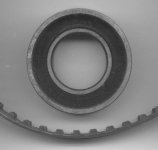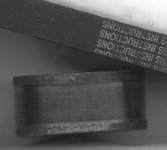trublu,
Re: the small wire, yes, what the 'somebody' said was correct, as I alluded to in my post. When you first turn on the key, that small wire is 'grounded' (0V) because the alternator outside windings are not generating any voltage. That wire goes to the warning light (as you said) and the other side of the warning light has 12V from the ignition switch. Therefore, the light comes on.
What is actually happening, though, is that the small current flow through the light is also going through the alternator outside windings, creating a (weak) magnetic field. The rotating part of the alternator also has windings (the armature) and these have battery current fed into them by two brushes. So, the rotating part has a strong magnetic field.
Now as the engine starts and runs, the interaction of the magnetic fields creates a strong current in the outside (stationary) windings, which is rectified by the diodes and voltage regulator (built-in to the alternator). Now that small wire has at least 12V on it (actually about 14.2V), as a result of the 'strong current'. The warning light therefore has voltage on both sides of it - so it goes out.
Sorry for all the theory but it's necessary to explain the following. If the small wire is missing, there is no initial weak magnetic field in the outside (stationary) windings. So as the rotating magnetic field begins to turn, it is spinning freely without any opposing field. HOWEVER it does excite a voltage in those windings once a certain RPM is reached (I think about 2000-3000) sufficient to activate the regulator and so the alternator does actually produce an output even though it was slow to start.
I'm basing this statement on my own observations plus what I have read about getting alternators to work in different cars. Please, if anyone else has corrections or specifics, chime in now!
For example, there was a question to a magazine where the light would only go off once over a certain RPM. It turned out the warning light was originally for a dynamo and was of insufficient wattage - the bulb was not giving enough current flow to set up the magnetic field in the stationary outside windings. A light went on in my head (if you'll excuse the pun) because I have noticed that in an Uno instrument cluster, the no-charge warning light has a larger bulb than all the others!
<deep breath> sorry, this post was rather technical, and not what would be 'in the manual'... but there's the theory. Now we need to get down to the PRACTICE... namely why is your alternator not charging... I'm still a little confused by the symptoms. Here are some common causes I have experienced:
Warning light does not come on when key turned on: broken wire contact (but sounds like you have fixed this?), blown bulb
Warning light comes on, but stays on with engine running:
1. bright: Alternator regulator faulty, alternator diodes faulty, drivebelt broken
2. dim, but getting slightly brighter with headlights switched on: Worn brushes
3. dim, same brightness at all times: Instrument panel faulty, alternator diode faulty
Note that for possibility 2. it can happen that the warning light is not on, but the alternator is not actually charging the battery (as I said in my previous post). This may be the case with your alternator - brushes may be worn, business with the warning light not being on is coincidental.
If I was faced with your car, here is what I would do:
1. Remove battery from car and charge slowly (3A or so for at least 12 hours, 'low' if you have a charger with several rates).
2. Check the voltage of the battery. Should be at least 12.3V. If less, buy or borrow a good battery before continuing.
3. Refit battery to car, check all connections in place, and start engine.
4. Check that warning light came on and goes out correctly. If not: check belt tension, if that's OK, then alternator is bad.
5. Check voltage at battery with engine running. Should be about 14V - but in any case more than it was with battery out of car.
6. Switch engine off and wait a couple of minutes.
7. Check battery voltage again. Should be less than it was in step 5, probably about 12.3V.
8. If you pass all the above tests, everything seems fine.
If you find that the voltage at the battery is no greater with engine running than it is with engine not running, then clearly the alternator is not contributing anything! And I would then take it off for replacement brushes and possibly a parts swap with a known-good alternator, depending on how bad the brushes were. They should have at least 3mm sticking out (I think your manual will say 5mm); if they have less than this, I would reassemble with new brushes and retest, before replacing other parts.
Also about the brushes - factor-in to your consideration the number of miles the car has done. I would expect the brushes to be worn-out somewhere around 120,000 miles, so if you have only done (say) 50,000 miles, it is more likely that you have a fault with the regulator or diodes.
If you wanted to be more thorough, you could do a proper test of the alternator current output. Generally-low current might be the brushes bad, while no current or a fixed low current could be regulator/diodes. Current meters go in series with the wire that bolts to the alternator. With headlights on high beam, and all electrical accessories working, and engine revved to perhaps 2500RPM, you should see a current of 30-40 amps - but it is hard to say, it depends on the condition of the battery (worse condition would mean higher amps going into it). The alternator can produce up to a maximum of 45A on the 999cc Uno, but you are unlikely to reach this with just headlights, wiper etc. on. This is why an auto electrician has a 'load tester' that will produce a more accurate result. Also, never disconnect the battery with the engine running - that will damage the alternator's regulator and probably the engine's electronic ignition as well. So - on the whole - I don't think it's worth bothering with this test, just check the voltage and go from there.
This must set a record for 'longest post' - but let us know how it goes and it will be worth it

-Alex



